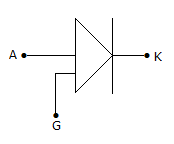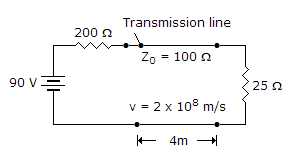Discussion
Home ‣ Electronics and Communication Engineering ‣ Materials and Components See What Others Are Saying!
- Question
In a valence crystal, the valence electrons
Options- A. are not shared
- B. are shared between neighbouring atoms
- C. are shared by all atoms
- D. any of the above
- Correct Answer
- are shared between neighbouring atoms
ExplanationIn true valence crystals the binding between the atoms is accomplished by the sharing of valence electrons.This sharing can only be between neighbouring atoms only.
More questions
- 1. The symbol in figure is for

Options- A. UJT
- B. PUT
- C. SCS
- D. SBS Discuss
Correct Answer: PUT
- 2. Which of these devices can conduct in both directions?
Options- A. SCR
- B. SUS
- C. SBS
- D. UJT Discuss
Correct Answer: SBS
- 3. In the given figure forward current wave has a magnitude of

Options- A. 0.45 A
- B. 0.3 A
- C. 0.2 A
- D. 0.1 A Discuss
Correct Answer: 0.3 A
Explanation:

- 4. A typical signal strength received from a geosynchronous communication satellite is of the order of a few
Options- A. milliwatts
- B. kilowatts
- C. picowatts
- D. watts Discuss
Correct Answer: picowatts
- 5. The temperature at which some materials become superconductors is called
Options- A. Transition temperature
- B. Curie temperature
- C. Neel temperature
- D. Onnes temperature Discuss
Correct Answer: Transition temperature
- 6. The advantage of modified series inverter with two inductors and two capacitors is
Options- A. the intermittent operation of battery is avoided
- B. efficiency of circuit is more
- C. the output frequency is low
- D. all of the above Discuss
Correct Answer: the intermittent operation of battery is avoided
- 7. A chopper cannot be line commutated.
Options- A. True
- B. False Discuss
Correct Answer: True
- 8. Three point tracking can be achieved with
Options- A. gang condenser
- B. variable selectivity
- C. paddar capacitor
- D. any of the above Discuss
Correct Answer: variable selectivity
- 9. In TE and TM modes of rectangular waveguides having propagation in z direction
Options- A. Ez and Hz are both zero
- B. In TE mode Ez is zero and in TM mode Hz is zero
- C. In TE mode Hz is zero and in TM mode Ez is zero
- D. In both TE and TM modes both Ez and Hz are non-zero Discuss
Correct Answer: In TE mode Ez is zero and in TM mode Hz is zero
- 10. Standard AM radio broadcasts are confined to
Options- A. MF
- B. HF
- C. VHF
- D. UHF Discuss
Correct Answer: MF
Comments
There are no comments.
- 1. The symbol in figure is for
More in Electronics and Communication Engineering:
Programming
Copyright ©CuriousTab. All rights reserved.
